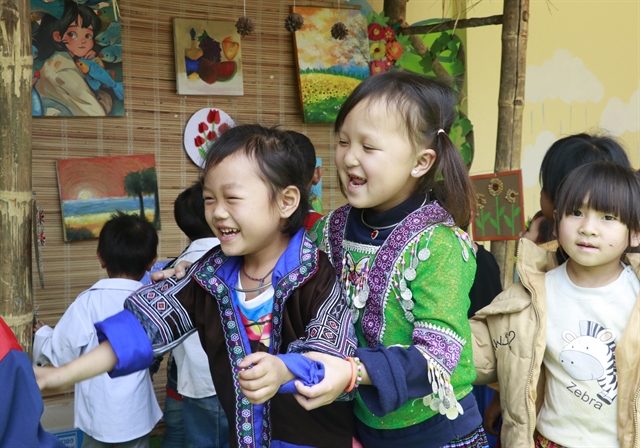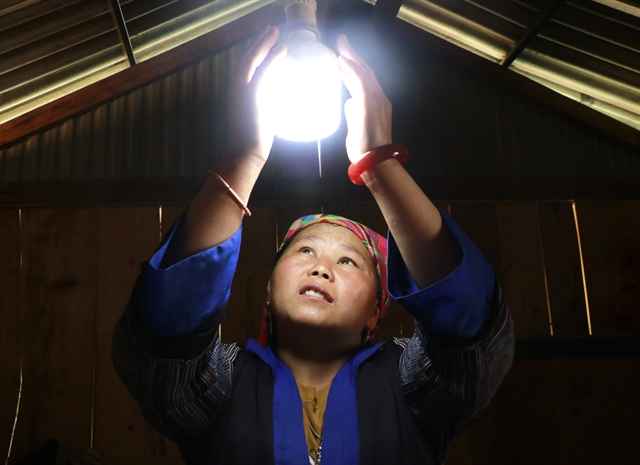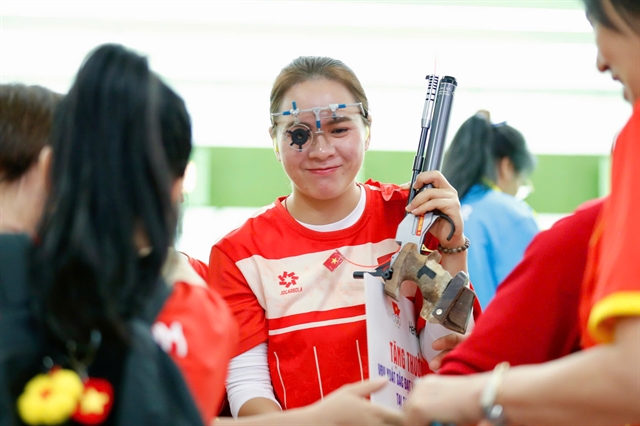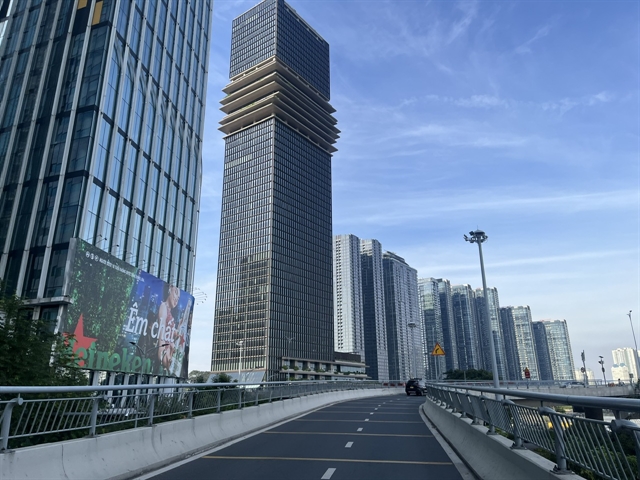 Society
Society

 |
| Mông children in Mù Cang Chải mountainous district in Yên Bái Province are happy when going to class to meet their teachers and friends. — VNA/VNS Photo Đinh Thuỳ |
YÊN BÁI — Yên Bái Province is the first locality in the country to include a ‘happiness’ criterion in the provincial Party Congress’s Resolution for the 2020-2025 term, aiming to build a happy province.
Accordingly, the people’s happiness index is an important measure for sustainable development.
Over the past four years, the people’s happiness index construction and improvement has led to positive changes, improving their material and spiritual life.
Platform from resolution
In the 2020-2025 term, Yên Bái chose the goal of ‘calling for and effectively using all resources for rapid and sustainable development in the direction of green, harmonious, unique and happy development; promoting cultural values, building friendly, benevolent, united and creative Yên Bái people’.
The province has identified ‘improving the happiness index for the people’ as a key task and core value in the development strategy.
This is an important driving force to successfully achieve the goal of making Yên Bái a fairly developed province by 2025, and among the leading developed provinces in the northern midlands and mountains by 2030.
Based on local practice, Yên Bái consulted experience of an economic and social research organisation in the UK.
The province evaluates happiness index based on three main specific groups of criteria, including satisfaction with life (factors related to living conditions, employment, income, family relationships, social relationships, relationships with the Government); satisfaction with the living environment (the Government's attention to building urban and rural landscapes, preserving the ecological environment, protecting the water environment and treating wastewater, waste, protecting forests and green environment); assessment of average life expectancy (the number of healthy years of people).
Each main criteria group is specified into 12 component criteria and 36 specific indicators.
Deputy Chairwoman of the provincial People's Committee Vũ Thị Hiền Hạnh said that to improve the happiness index for people, from 2021 to now, the province had issued many plans, resolutions, projects and policies across many fields.
In particular, the province has focused on allocating resources and issuing policies for socio-economic development in highland and ethnic group areas, ask for participation of the entire political system, the consensus of the people, across all groups, to build an increasingly happier life.
This is an important basis for building and improving the happiness index for local people, linking the goal of harmonious development between economy and culture, society, between economy and environment, between lowland and highland areas, between rural and urban areas, preserving and promoting the cultural identity of ethnic groups.
Every year, the provincial Party Committee assigns specific tasks to each sector, locality and agency.
Thanks to that, each unit can identify urgent and long-term solutions, with specific results and products, reflecting the characteristics of each sector and locality.
Practical model
 |
| The happiness of the people in Mù Cang Chải when they have light from the national power grid. — VNA/VNS Photo Đinh Thuỳ |
In the past, it was very difficult for children in highland villages to go to school, and the students’ attendance rate was low due to people's awareness and living conditions.
But now, children can go to school, acquire knowledge and benefit from educational policies, especially since the ‘Happy School' model implementation, students all love going there.
Every day at school for Lê Minh Ngọc, a student of class 3A1 at the Mù Cang Chải Primary and Junior Secondary School, is a happy day.
In a clean and tidy learning space, Ngọc and her friends are taught, loved and imparted knowledge by their teachers.
Not only do they study, but Ngọc and her friends also participate in extracurricular activities with useful experiences.
Welcoming students to school, teacher Nguyễn Thị Thuý, Deputy Principal in charge of the primary school under the Mù Cang Chải Primary and Junior Secondary School, said that for teachers in the highlands, everyone feels happier when students are eager to go to school.
Since conducting the ‘Happy School’ model, students’ attendance rate has changed significantly.
The school regularly organises extracurricular activities so students feel that school is their second home and family.
Not only is the ‘Happy School’ model effective, Mù Cang Chải District also focus on building ‘Happy Villages’ with the goal that every person lives happily, healthily, unitedly and is satisfied with life and the surrounding living environment.
Secretary of the Mù Cang Chải District Party Committee Giàng A Câu said that with the viewpoint of ‘taking people's happiness as the core value, the measure of development’, over the past four years, the district has effectively supported production, tourism services, national target programmes in the area, contributing to poverty reduction and increasing income for people.
Every year, the poverty reduction rate of the district reaches over 8.37 per cent.
Last year, the life satisfaction index reached 51.4 per cent, the average life expectancy index reached 76.13 per cent, the environmental impact assessment index reached 70.76 per cent, and the people's happiness index was at level one - quite happy.
"The above results show that the happiness index has truly become an important driving force and spiritual foundation to promote Party committees at all levels in Mù Cang Chải District to make every effort to overcome difficulties and successfully carry out tasks", said Câu.
This year, the district strives to increase the people's happiness index by 2.14 per cent compared to last year.
More efforts
Yên Bái is the first locality in the country to implement the happiness index, therefore, the province cannot avoid difficulties and obstacles.
Specifically, a survey report showed that the happiness index of Yên Bái people last year is 66.52 per cent, reaching level two – quite happy, an increase of 0.9 per cent compared to 2023.
However, it did not meet the target of 68 per cent, one reason being that in early September last year, Typhoon Yagi caused severe damage.
After the typhoon, some factors related to the economic and material conditions of the people were affected, such as housing, traffic infrastructure, irrigation, employment, income, cultural and artistic enjoyment and learning facilities.
Yên Bái Provincial Party Secretary Trần Huy Tuấn said that, based on the practical situation, the province reviewed, analysed and clarified further the reasons for not achieving last year's target.
From there, it developed plans, tasks and key solutions to overcome shortcomings and limitations.
The province will ensure that the set target this year, the happiness index of the people reaches 68.3 per cent. In particular, the life satisfaction index reaches 58.66 per cent, the average life expectancy index reaches 79.21 per cent, and the environmental impact assessment index of the place where they live is 68.03 per cent.
To achieve the objectives, the province quickly completes the socio-economic infrastructure, especially in remote and ethnic group areas, and pushes up investment and transport infrastructure projects in regional and inter-regional areas.
It also promotes administrative reform, improves the quality and efficiency of investment attraction, creates jobs, and enhances the quality of people's lives. — VNS




